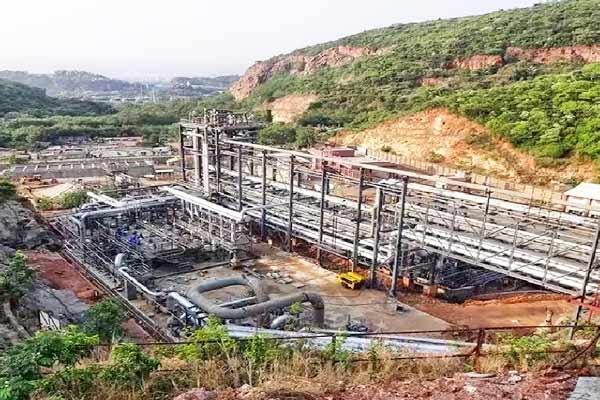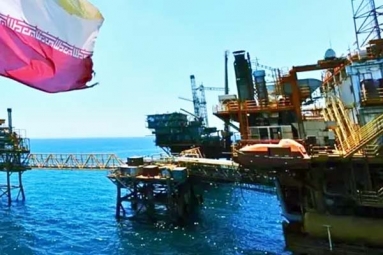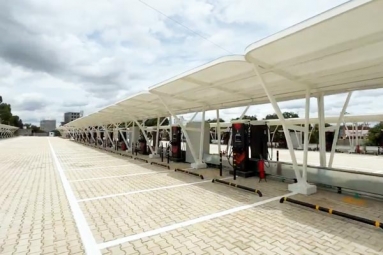
(Image source from: Zeenews.india.com)
Concerns are rising that Iran may try to intervene in the Strait of Hormuz amidst the current tensions involving Israel and the United States. Such actions could lead to shortages in supply and an increase in oil prices, impacting India, which is the largest global importer of crude oil, along with other consumers. As the fear of an expanded conflict grows due to Israeli and US operations targeting Iran, gas and crude prices have already escalated. Nevertheless, India seems unfazed by these price variations. According to Petroleum and Natural Gas Minister Hardeep Singh Puri, India's varied sources of crude supply and the fact that a considerable amount does not transit through the Strait of Hormuz serve as protective measures. Additionally, what Puri did not mention is that India's stability is further enhanced by its strategic oil reserves, which are stored in underground rock chambers at three main sites. India keeps several million metric tonnes of crude oil in its Strategic Petroleum Reserves (SPR) located in rock caverns in states like Andhra Pradesh, Karnataka, and Tamil Nadu.
Further development of two additional SPR sites is underway in Odisha and Karnataka. This outlines how the escalating crisis in the Middle East could potentially disrupt oil supplies and demonstrates how well India is prepared to address such challenges. The intensifying conflict between Iran and Israel, which has now reached the twelfth day, has introduced fluctuations in global oil markets, largely due to the area's geographical significance. Iran is one of the leading oil exporters globally and is positioned near the Strait of Hormuz. Other nations in the Persian Gulf, located just east of this crucial chokepoint, such as Saudi Arabia, Kuwait, and Iraq, depend on this narrow channel, only 33 kilometers wide at its narrowest point, to transport most of their crude exports. This situation also applies to significant natural gas exports, as countries like Iran, Saudi Arabia, and Iraq are among the major global gas suppliers.
Following the Iranian Parliament's (Majlis) decision on Sunday to back the closure of the Strait of Hormuz in retaliation to US assaults, fears regarding possible supply interruptions, including for India, have distinctly heightened. As the third-largest oil importer and consumer in the world, India depends on foreign sources for about 80% of its crude oil consumption, which is steadily increasing. Recently, Brent crude oil prices, one of the principal global indicators, climbed to $78.93 per barrel, with analysts from firms like Goldman Sachs and JP Morgan cautioning that prices could soar to around $140 if the Strait were obstructed. However, Brent prices have since decreased to $71.48 per barrel, as have those of the other major measure, the West Texas Intermediate (WTI) crude oil. These benchmarks, Brent and WTI, are extensively used to set global oil prices, mirroring supply-demand dynamics in international markets. Brent is predominantly utilized for crude traded across Europe, Asia, and Africa, which is particularly relevant for India, since much of its oil is transported through the Strait of Hormuz, whereas WTI is primarily associated with the US market.
Despite facing numerous challenges, India has shown resilience, with Petroleum Minister Hardeep Singh Puri highlighting the country’s essential defense against fluctuations in prices and supply issues. Acknowledging its heavy dependence on imports, India has notably broadened its sources of crude oil imports over the years to reduce exposure to the unpredictable market dynamics of the Middle East. The United States, Nigeria, Angola, and Brazil have emerged as key suppliers, even though accessing these nations requires navigating longer maritime routes, such as through the Suez Canal, Panama Canal, or around the Cape of Good Hope, which increases transportation duration and costs. This strategy of diversifying imports has provided India with a way to avoid dependency on the Strait of Hormuz.
Additionally, despite the Western sanctions imposed, India has sustained its oil purchases from Russia and is anticipated to raise its imports to a two-year peak of 2.2 million barrels per day. This figure will exceed the total quantities purchased from Saudi Arabia and Iraq, according to the analysis performed by Kpler, a global trade analytics firm. Although tensions have led to disruptions in the Strait of Hormuz, the waterway has never been completely blocked during previous conflicts in the area. Indian refineries possess the capability to quickly adjust to interruptions in supply. Long-term agreements with nations such as Saudi Arabia, Iraq, and Russia further bolster India’s supply security, mitigating its susceptibility to changing geopolitical landscapes. Oil-importing companies in India typically exercise strategic timing in their crude purchases, given that these deals involve significant foreign exchange expenditures. This is where India’s Strategic Petroleum Reserves (SPR), which are stored in underground rock caverns, become crucial.
Managed by the Indian Strategic Petroleum Reserves Limited (ISPRL), part of the Ministry of Petroleum and Natural Gas, India’s Strategic Petroleum Reserves (SPR) serve as a vital component of the nation’s energy security framework. Currently, there are three underground caverns located 90 meters beneath the surface, each extending up to a kilometer in length, and their height is comparable to that of a 10-storey building. Among these, India’s LPG cavern in Visakhapatnam, which descends to 196 meters below mean sea level, is recognized as one of the deepest fuel storage facilities in the world. These three facilities collectively hold 5.33 million metric tonnes (MMT) of crude oil, roughly matching the country’s daily consumption of about 5 million barrels. Furthermore, plans are in progress to establish additional storage locations. In 2021, the government sanctioned the creation of two extra commercial-strategic petroleum reserve facilities with a total capacity of 6.5 MMT at Chandikhol (4 MMT) in Odisha and Padur (2.5 MMT) in Karnataka, to be developed through a Public-Private Partnership (PPP) approach, as stated in a press release from the ministry.
As of now, India has accumulated a reserve of 5.33 million tonnes of crude oil, which is equivalent to approximately 38 million barrels. This quantity can satisfy about 10 days of the total crude oil usage in the country based on figures from 2019-2020. Following the completion of Phase II, it is anticipated that India's total crude reserves will increase sufficiently to fulfill up to 22 days of national demand. However, the reserves stored in caverns are not India’s only resource; the inventory held by oil marketing companies can enhance this stockpile further. According to Sumit Pokharna, vice president at Kotak Securities, "India's daily oil consumption stands at around 5 million barrels, meaning this reserve can sustain about 9 to 10 days of crude necessity without imports. While the commercial supplies held by oil marketing firms can extend this buffer to nearly 74 days collectively, a complete halt in imports would pose significant challenges for running the country."
This reservoir of crude positions India comfortably amidst global supply challenges, functioning as a cushion against disruptions. In 2020, when a significant drop in oil prices occurred due to the Covid-19 pandemic, India seized the moment to purchase crude and store it in its subterranean caverns, resulting in savings of about Rs 5,000 crore, as reported by the ministry. These caverns are optimal for safeguarding strategic crude holdings. For a densely populated and geopolitically vulnerable nation like India, underground caverns offer a secure, efficient, and economically viable means to store strategic oil reserves. They are inherently protected from aerial assaults, sabotage, and natural calamities unlike surface tanks. Additionally, caverns reduce evaporation losses and lower environmental hazards.
The underground rock caverns are designed to be sealed and are installed with monitoring systems to prevent oil leaks or contamination from water and other substances. They are also equipped with emergency measures to detect and manage potential leaks.
The idea of storing crude in caverns initially emerged in Sweden as a measure for wartime safety and was later embraced by other nations including Finland, Japan, and South Korea. In India, the concept began to evolve in 1998 during Atal Bihari Vajpayee's premiership, influenced by the lessons learned from the Gulf War of 1990. Presently, India is continually evaluating new locations for the expansion of its strategic reserves, an effort that will persist until there is a significant reduction in the country’s reliance on fossil fuels, which the petroleum ministry is currently aiming to achieve.









